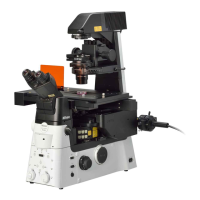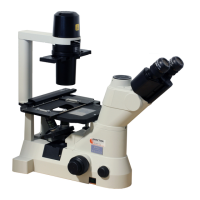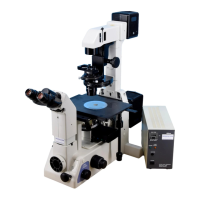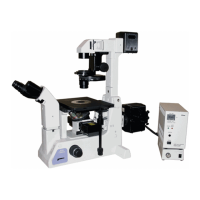Chapter 6 Maintenance and Storage of the Device
117
6.1.1 Cleaning the Lenses
Keep the lenses free of dust, fingerprints, and other dirt. Any dirt on lenses and filters will degrade the image
quality. If the lenses become dirty, clean them according to the following procedure.
Cleaning off minor dirt (such as dust)
(1) Blow dust off using an air blower.
(2) If this is insufficient, brush away dust with a soft brush or wipe away gently with a piece of gauze.
Cleaning off heavy dirt (such as fingerprints or oil stains)
Lightly moisten a piece of soft, clean cotton cloth, lens cleaning tissue, or gauze with absolute alcohol (ethyl
or methyl alcohol) and wipe the dirt off.
Tips on cleaning lenses
Do not reuse cotton cloth, lens cleaning tissue, or gauze that has already been used.
Cleaning the NAMC condenser module
The NAMC condenser module has built-in plastic optical elements. When cleaning this module, simply
clean it with a blower.
Wiping plastic optical elements with lens tissue might cause a scratch on the surface and wiping with
solvent might damage the surface. At the time of assembly, take care that the plastic part is free of dirt;
especially avoid touching this part by hand.
6.1.2 Cleaning Parts other than Lenses
Cleaning off minor dirt (such as dust)
Wipe off using a silicone cloth.
Cleaning off heavy dirt (such as fingerprints or oil stains)
Lightly moisten a piece of gauze with a neutral detergent and wipe the dirt gently.
6.1.3 Cleaning Off Immersion Oil
(1) Wipe off using petroleum benzine.
(2) Then, finish off the cleaning with absolute alcohol (ethyl or methyl alcohol.)
If petroleum benzine is unavailable
If petroleum benzine is unavailable, use methyl alcohol.
Note that methyl alcohol is less effective, and requires more wipes.
6.1.4 Decontaminating the Product
Use 70% medical alcohol for routine disinfection of the product.
Use of organic solvents on plastic parts may result in discoloration.
Never use any form of hydrogen peroxide (H
2O2) to decontaminate this product, because it might cause
various precision components in the microscope to deteriorate.
Handling a hazardous specimen
If a specimen comes into contact with this product, check if the specimen is hazardous.
If the specimen is hazardous, follow the standard procedure of your laboratory.
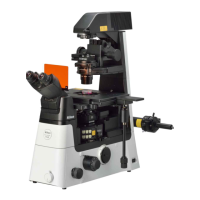
